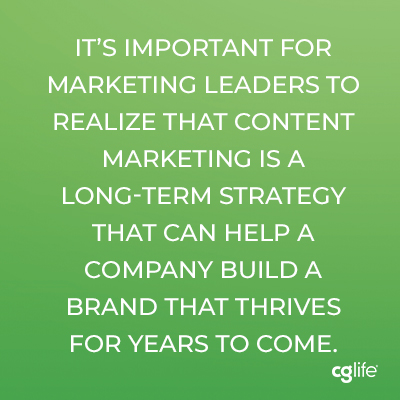We’ve all heard the phrase content is key , but usually, decision-makers question the real return on investment (ROI) for creating and distributing content for free. And rightly so. After all, it can take hours to write a blog post or create a video. More hours to edit and perfect that piece of content. And perhaps a few more hours to do the relevant research and properly optimize the content for search engines. And let’s not forget about distributing the content to (potentially) the audiences we want to attract!
Creating and distributing content takes time and can take even longer to gain traction. So why should health and life science companies care about content marketing?
It is not unusual for stakeholders to choose paid advertising and public relations strategies as preferred ways to generate awareness quickly and make sales. Like any marketing strategy, when paid advertising and public relations strategies are carried out correctly, they yield marvelous results. In our experience, however, building a sticky and memorable brand that survives the long haul is best done by adding content marketing to the mix.
While we know that content is key, getting here can be murky sometimes, so let’s start by defining what content marketing is. Then, we’ll talk about the steps your company can take to derive the most benefit from your content marketing strategy.
According to Hubspot, content marketing is creating, distributing, and publishing content to reach a target audience to increase brand awareness, sales, engagement, and loyalty.
From whitepapers to infographics, e-books to blog articles, types of content within life science marketing varies.
Now let’s talk about how to ensure that content is not working against your company, and instead, working with your goals to increase brand awareness, sales, engagement, and loyalty.
Plan Your Content Ahead****

For content marketing to be successful, it is important to have a plan to create, publish, and distribute your content.
Not having a plan is one of the first mistakes we see companies make that try their hand at content marketing.
In what I like to call “random acts of content,” companies will produce content that does not necessarily align with the goal they’re trying to achieve. This tactic can distract from your overall goals and, in the end, hurt what you are trying to achieve. Your content must be directly tied to the mission and objectives of your company.
A content plan can include:
- The content topics and how they will support your company’s products and services
- The types of content your company wants to create on a consistent basis. Do you want to write blog posts? Produce whitepapers? Create videos? It’s important to know which kinds of content your company wants so you can create a plan on how to execute them.
- Choose how often your company wants to distribute this content. This will help steer the creation of your content schedule or calendar. While regular content (e.g., weekly) may be more effective than content distributed quarterly, what matters most is having a consistent schedule.
- Specific channels to publish your content on.
Stay Focused****
Who is the target audience for the product or service you’re trying to highlight or sell?
It’s easy to fall into the trap of creating content for anyone who will listen, but this is seldom an effective approach. Successful content marketing has a specific reader and, ultimately, a specific buyer.
Is it:
- Laboratory directors who make decisions about which diagnostic test to purchase?
- The infectious disease professional in charge of purchasing disinfectant wipes for a hospital?
- Parents of a premature baby anxiously looking for an evidence-based solution to supplement their infant’s nutrition?
As you can see, these are unique audiences with unique needs, motivations, and intents. Even within a company that serves multiple audiences, it is important to segment the audience and create content suited for them to cultivate the engagement, sales, and ultimately the loyalty you’d like to see from customers.
Not sure who your audience is? Now might be an excellent time to survey them to help you learn more about them and their needs so your company can create content that resonates and moves them into action. Having distinct content buckets that address audience-centric needs is a helpful tactic when creating content.
Patience is a Virtue****
Effective content marketing is a long-term strategy that requires patience. Take search engine optimization, for instance. Even with the best strategies, it can take three to six months for SEO-optimized content to appear in search engines.
Furthermore, people who read a post or watch a video today may take another year before they are in a place or position to buy from your company. In this case, marketers and company leaders must be willing to trust the process of content marketing.
For Good Measure
What gets measured gets improved.
Using a tool like Google Analytics is a must if you plan to create blog content or any other type of content.
Analytics tools on social media platforms that distribute your content may also help estimate the types of content that resonate most with your audience. You will also learn what other pages readers visit and whether sales or leads were generated from that specific action.
Studying your content’s data will provide insights into what content to create more of and can reveal gaps in the information.
Fueling the Organic Content Fire
One of the powerful effects of paid advertising and PR strategies is that they can feed the flames of your organic content.
For instance, let’s say you’ve done everything we’ve shared with you in this post so far.
- You have a well-defined audience.
- You have a solid content plan which includes plans for creating, publishing, and distributing your content.
- You are set up to measure the effectiveness of your content.

PR opportunities and paid content will take the helpful and informative content further. Many of the potential customers finding you for the first time through a press release or a paid ad will want to know more before making a purchasing decision.
If you’ve already done what we’ve discussed above, you can establish authority quickly, build trust, and shorten the time it takes a potential customer to invest with you and your company.
Content marketing works when executed the right way. It’s important for marketing leaders to realize that creating content is key to a long-term strategy that can help a company build a brand that thrives for years to come.
We hope the advice we’ve shared in this post will help jumpstart or improve your content marketing strategy, and as always, we’re happy to lend a hand if you need it!
